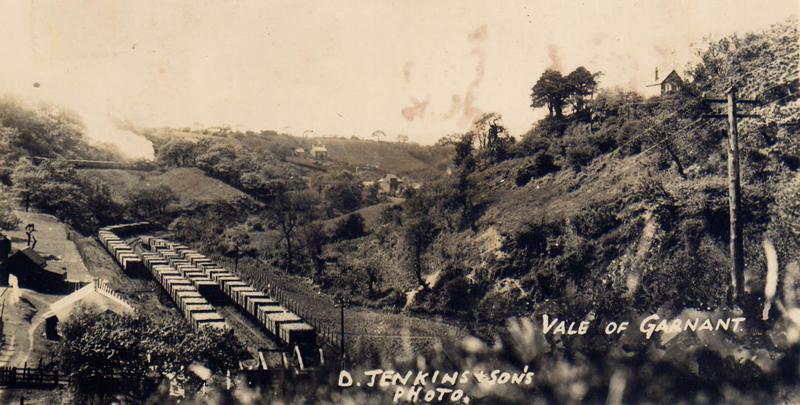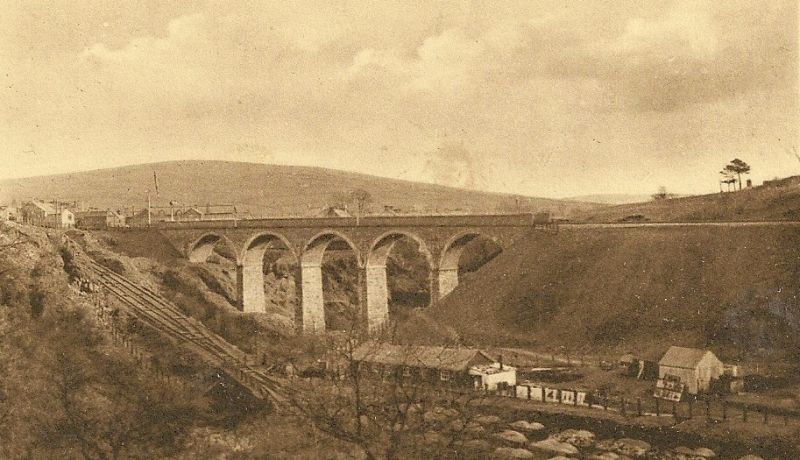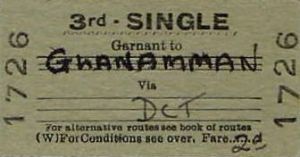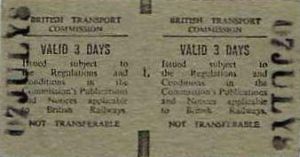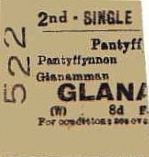Some Captured History of Glanamman and GarnantCwmamman's RailwayThe Llanelly Railway and Dock Company opened its line from Pontardulais to Cwmamman on the 10th of April, 1840 and this was used for carrying both passengers and goods. The passenger line allowed travel from Swansea and Llanelly. On Saturdays a late train would leave the two towns for Cwmamman as late as 10pm. This was commonly known as the "Rodney". The railway was extended to Gwaun-cae-gurwen on the 6th of May, 1841. The track followed the River Garnant up the valley and climbed a steep hill (gradient 1 in 4.9), approximately 132 yards (or metres) long, before reaching the village. The line served two collieries on the way; one of these, the New Cawdor Colliery, had a tramway leading to the railway via an incline on the south side of the valley. In June of 1842, Garnant became a junction, when a new railway line was opened to Brynamman. The original railway station at Garnant was behind the Prince Albert public house (opposite the Colliers Arms), near the Gors-y-garnant crossing and approximately 100 yards (100 metres) from the main road. This was a small station, consisting of a platform and no building. Later a larger station was constructed in the centre of Garnant and a railway station was also built at Glanamman, approximately 100 yards (100 metres), to the north of the village square. Glanamman Railway Station was once known as Cross Keys Station. Five dwelling houses were built by the railway company for the use of their employees. Two of these houses were sited near the engine shed, another by Gors-y-garnant crossing and two by the station. All have long since been demolished. Two engines were used on the line; one for transporting goods, the other for transporting passengers. When not running, they were kept in a railway shed on the Gwaun-cae-gurwen goods line, opposite the Globe Inn at the eastern end of Garnant. The Llanelly Railway line was taken over by The Great Western Railway on the 1st of January 1873.
Old railway line (Cawdor Line) with old Garnant Colliery buildings in centre background On the 4th of November, 1907, a new single track was opened by the Great Western Railway. This started just east of the Raven Crossing, at the east end of the branch platform at Garnant. It rises at a gradient of 1 in 40 throughout its length, which is just over one and a third miles (just under 2.2km). The new track begins on the north side of the old branch, but crosses over it after about half a mile and cuts across the south west side of the valley, crossing a viaduct. The viaduct consists of 5 arches, 66 yards (or metres) long, with a maximum height of 30ft. Beyond this, it immediatedly follows the course of the old line, west of the level crossing at Gwaun Cae Gurwen.
Gwaun Cae Gurwen Viaduct c.1920 showing the old railway incline When the new line opened, just under half a mile (approx 1.3km), of the old track to Gwaun-cae-gurwen was closed. The remainder continued under the name of the Cawdor Branch and served two collieries. The sidings at the foot of the incline were removed in 1933 and the rails were lifted from the rest of the branch in 1950. The Great Western Railway started a passenger service from Garnant to Gwaun-cae-gurwen on the 1st of January 1908, using a steam railcar. The service consisted of 8 trips per day, stopping at Gors-y-garnant, Red Lion Crossing and the terminus which was just west of the Level Crossing at Gwaun-cae-gurwen. This service continued until June, 1926 and probably ceased because of the General Strike. The railway industry was nationalised from the 1st of January 1948
and Cwmamman was then served by "British Railways; Western Region".
The passenger service from Pantyffynon to Brynamman (via Ammanford,
Glanamman and Garnant) continued until 1958. The last passenger train
from Pantyffynnon to Brynamman was scheduled to leave Pantyffynnon at
10:34 pm on Saturday the 16th of August 1958. Because there were so
few people using the line to Brynamman, BR estimated that by closing
it, they would save £16,244 per year.
3rd Class Single Ticket dated 7th July 1958, Garnant to Glanamman, priced 2d.
Coal trains continued to use the Cwmamman Railway after this time. After over a decade of disuse, an American Coco Locomotive (Class 66), travelled along the Cwmamman Railway from Pantyffynon to Tairgwaith on Monday the 12th of January, 2009. This was done in order to test the track and familiarise the engine driver with the route. Regular coal trains were reinstated on the Cwmamman Railway on the 16th of January 2009, to carry coal through Cwmamman to Onllwyn from East Pit Opencast Site at Tairgwaith. The train is expected to run three times a week, with each journey transporting approximately 70 lorry loads of coal. The Amman Valley Railway Society are also in negotiations with Network Rail in order to run a passenger service along the line periodically. The first passenger "Special" to travel through the valley since 1997 was seen on Saturday the 24th of March 2012 and was met with some awe by its spectators due to its size. The 13 carriage train, complete with 3 engines and carrying approximately 500 passengers was the longest passenger train ever to travel through Cwmamman. Unlike the passenger "Rambler Specials" of 1996 and 1997 which were arranged by the Amman Valley Railway Society, the 2012 special was arranged by Pathfinder Tours of Gloucester and ran from Crewe to Tairgwaith and back on its day trip. There have been several accidents on the Cwmamman Railway, sometimes due to the victims trespassing on the line. It was commonplace for local men to use the railway line as a shortcut and this sometimes resulted in them being hit by a train. The injuries resulting from such collisions could be terrible, with death not always instantaneous, but resulting from the shock of dismemberment. The above information was taken from an article by C. L. Mowat in the "Railway Magazine", December 1957, The Amman Valley Chronicle and a clipping from an unknown newspaper (Author unknown).
|
